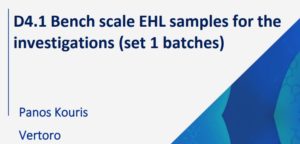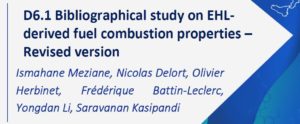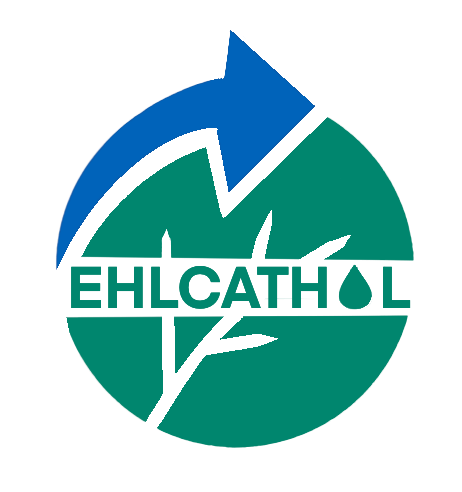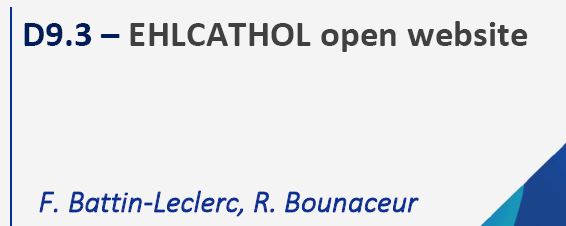Start
01 November 2020
End
31 October 2024
PUBLIC DELIVERABLES
Deliverables
Kick-Off meeting
D9.1‐ Communication strategy, logo and guide
 Deliverable 9.1 reports on the project visual identity set created to promote the project. The project identity includes the creation of a logo, of a leaflet (project presentation including the challenges/context of the project, objectives, results/applications, consortium), as well as templates for the first page of EHLCATHOL deliverables and for EHLCATHOL presentations slides and an e-mail banner. The leaflet, templates and e-mail banner have been distributed to the consortium partners. In addition, Deliverable 9.1 presents the general lines of the communication strategies. The strategy set in order to facilitate the communication and dissemination will be fully detailed in D9.2. In addition, a Project public website (https://ehlcathol.eu/) is under development. Information needed to complete it has been requested from the consortium partners at the kick-off meeting of November, 23-24. Its complete description will be provided in D9.3.
Deliverable 9.1 reports on the project visual identity set created to promote the project. The project identity includes the creation of a logo, of a leaflet (project presentation including the challenges/context of the project, objectives, results/applications, consortium), as well as templates for the first page of EHLCATHOL deliverables and for EHLCATHOL presentations slides and an e-mail banner. The leaflet, templates and e-mail banner have been distributed to the consortium partners. In addition, Deliverable 9.1 presents the general lines of the communication strategies. The strategy set in order to facilitate the communication and dissemination will be fully detailed in D9.2. In addition, a Project public website (https://ehlcathol.eu/) is under development. Information needed to complete it has been requested from the consortium partners at the kick-off meeting of November, 23-24. Its complete description will be provided in D9.3.
D9.3 EHLCATHOL Open Website
D4.1 Bench scale EHL samples for the investigations (set 1 batches)
 The EU H2020 EHLCATHOL project aims to completely transform Enzymatic
The EU H2020 EHLCATHOL project aims to completely transform Enzymatic
Hydrolysis Lignin (EHL), a waste product from the 2G Bioethanol process, into high
performance fuel blends, i.e. high heating value jet fuel, high octane gasoline, and
high cetane number diesel. The EHLCATHOL research will focus on gaining the
knowledge for improving greatly the catalytic activity and stability, mechanism of
suppressing recondensation steps, solvation of login, selectivity to fuel molecules, product separation, fuel performance enhancement, combustion of the EHL biofuel, as well as reducing the environmental impact of the emission, all needed to develop the novel EHL catalytic solvolysis technology exploiting the energy, around 40% of the lignocellulose feed, stored in EHL with the highest efficiency. One of the important aspects of this project is the demonstration of the process’s scalability. One of tasks of Vertoro is to establish bench scale reaction protocols, in order to scale-up novel catalytic processes that will be developed by partners for the transformation of EHL lignin to fuel precursors. For that purpose Vertoro, put in operation a 4L batch Hastelloy reactor for the catalytic solvolysis of a technical lignin in a reductive environment, using a commercial hydrogenation catalyst. After post-reaction filtration of the unconverted lignin fractions, a lignin oil rich in phenolic monomers was obtained, which will be used for downstream upgrading and investigation by the EHLCATHOL partners.
D6.1 – Bibliographical study on EHL-derived fuel combustion properties
 Deliverable 6.1 is the first one in task 6.1, whose goal is to characterize the composition of the fuels derived from enzymatic hydrolysis lignin (EHL) and to define the associated molecular substitutes. The first step is to identify the most important chemical species that present in EHL-derived solvolysis oil though bibliographic study and by the experimental analysis using two-dimensional gas chromatography (GC-2D) of samples provided by the EHLCATHOL partners. The results of the characterization are of particular importance in the case of the biofuels in the EHLCATHOL project and will make it possible to define molecular substitutes, which represent the main families of chemical species (e.g. alcohols, ketones, esters, phenolic compounds and arenes) to study the combustion properties on solvolysis oil.
Deliverable 6.1 is the first one in task 6.1, whose goal is to characterize the composition of the fuels derived from enzymatic hydrolysis lignin (EHL) and to define the associated molecular substitutes. The first step is to identify the most important chemical species that present in EHL-derived solvolysis oil though bibliographic study and by the experimental analysis using two-dimensional gas chromatography (GC-2D) of samples provided by the EHLCATHOL partners. The results of the characterization are of particular importance in the case of the biofuels in the EHLCATHOL project and will make it possible to define molecular substitutes, which represent the main families of chemical species (e.g. alcohols, ketones, esters, phenolic compounds and arenes) to study the combustion properties on solvolysis oil.
D6.2 – EHL-derived molecular surrogate compositions
Deliverable 6.2 is the second one in task 6.1, whose goal is to characterize the composition of the
fuels derived from enzymatic hydrolysis lignin (EHL) and to define the associated molecular substitutes.
The first step is to identify the most important chemical species that present in EHL-derived solvolysis oil though bibliographic study and experimental analysis using two-dimensional gas chromatography (GC-2D) of samples provided by the EHLCATHOL partners. The results of the characterization are of particular
importance in the case of the biofuels in the EHLCATHOL project and makes it possible to propose molecular substitutes, which represent the main families of chemical species to study the combustion
properties on solvolysis oil.


